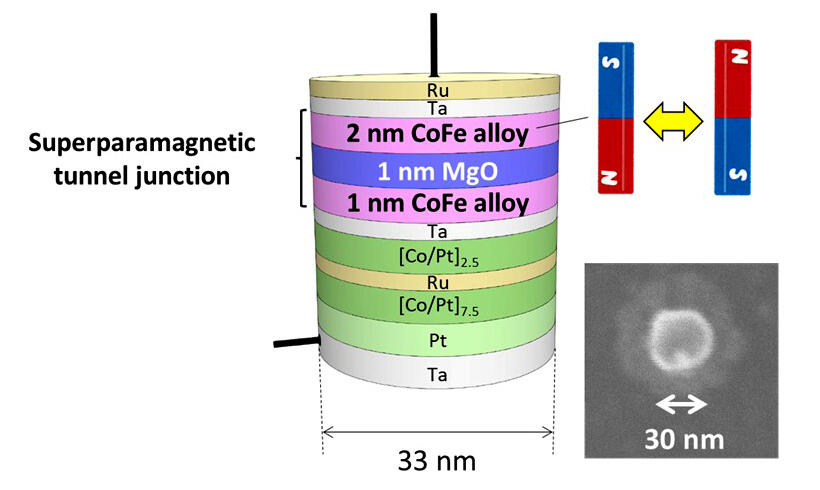Graduate student Takuya Funatsu (at the time of the research), Associate Professor Shun Kanai, Professor Shunsuke Fukami, and Professor Hideo Ohno (currently president of Tohoku University ) of the Research Institute of Electrical Communication (RIEC), Tohoku University, and Principal Scientist Jun'ichi Ieda of the Japan Atomic Energy Agency, have successfully measured the "magnetic energy landscape" of a nanomagnet experimentally for the first time in the world.

Provided by the Research Institute of Electrical Communication (RIEC), Tohoku University
In 2019, Tohoku University developed a magnetic tunnel junction device that functions as a pseudo-qubit and successfully demonstrated the proof of concept of factorization. The main principle of operation of magnetic tunnel junction devices for pseudo-qubits is their change in stability with input, which is comprehensively described as the "energy landscape." However, while energy landscape is the most important property when incorporating and controlling elements into actual circuits, it has been considered difficult to determine the energy landscape experimentally using actual elements because stability is so intricately related to magnetic properties and inputs.
The research group fabricated superparamagnetic tunnel junctions with a diameter of 33 nanometers, and when they used them to investigate the magnetic field and current at which the energy minimum vanishes, they were able to experimentally determine the switching exponent (a variable that distinguishes devices with different energy barriers) with an experimental method to investigate the energy barrier when applying a magnetic field and electric current. Combining these measurement techniques for the first time for a single element, they were able to reveal in detail how the dependence on the magnetization angle of magnetic energy varies with magnetic field and current.
In particular, by introducing the axes of the magnetic field and current onto a planar graph, they measured the energy landscape, which represents energy as contour lines, from which the switching exponent was revealed. The switching exponent they measured on an actual device revealed that the energy barrier changes as the voltage applied to the device is changed and that the switching exponent varies between 2 and 1.5. As a result, they were able to accurately predict the magnetic field and current dependence of the magnetic energy, and successfully measured the magnetic energy landscape.
In addition to accelerating research and development of probabilistic computers using superparamagnetic magnetic tunnel junction devices, determining the exponent that is valid for nanomagnets in general is expected to be used in the characterization of magnetoresistive random access memory (MRAM) using nonvolatile magnetic tunnel junctions in their research and development.
"It has become clear that the instability of the state is more sensitive to external inputs than theoretical predictions in devices of several tens of nanometers in size, which are used in practice," explains Kanai. "Applying this knowledge to the control of actual devices, we have succeeded in surveying the magnetic energy landscape of nanomagnets with high accuracy and speed using a pseudo-quantum computer, paving the way for large-scale optimization problems and other calculations. We are currently investigating the computational performance of relatively small pseudo-qubits, and plan to investigate the performance of large pseudo-qubits in the future."
Journal Information
Publication: Nature Communications
Title: Local bifurcation with spin-transfer torque in superparamagnetic tunnel junctions
DOI: 10.1038/s41467-022-31788-1
This article has been translated by JST with permission from The Science News Ltd.(https://sci-news.co.jp/). Unauthorized reproduction of the article and photographs is prohibited.




